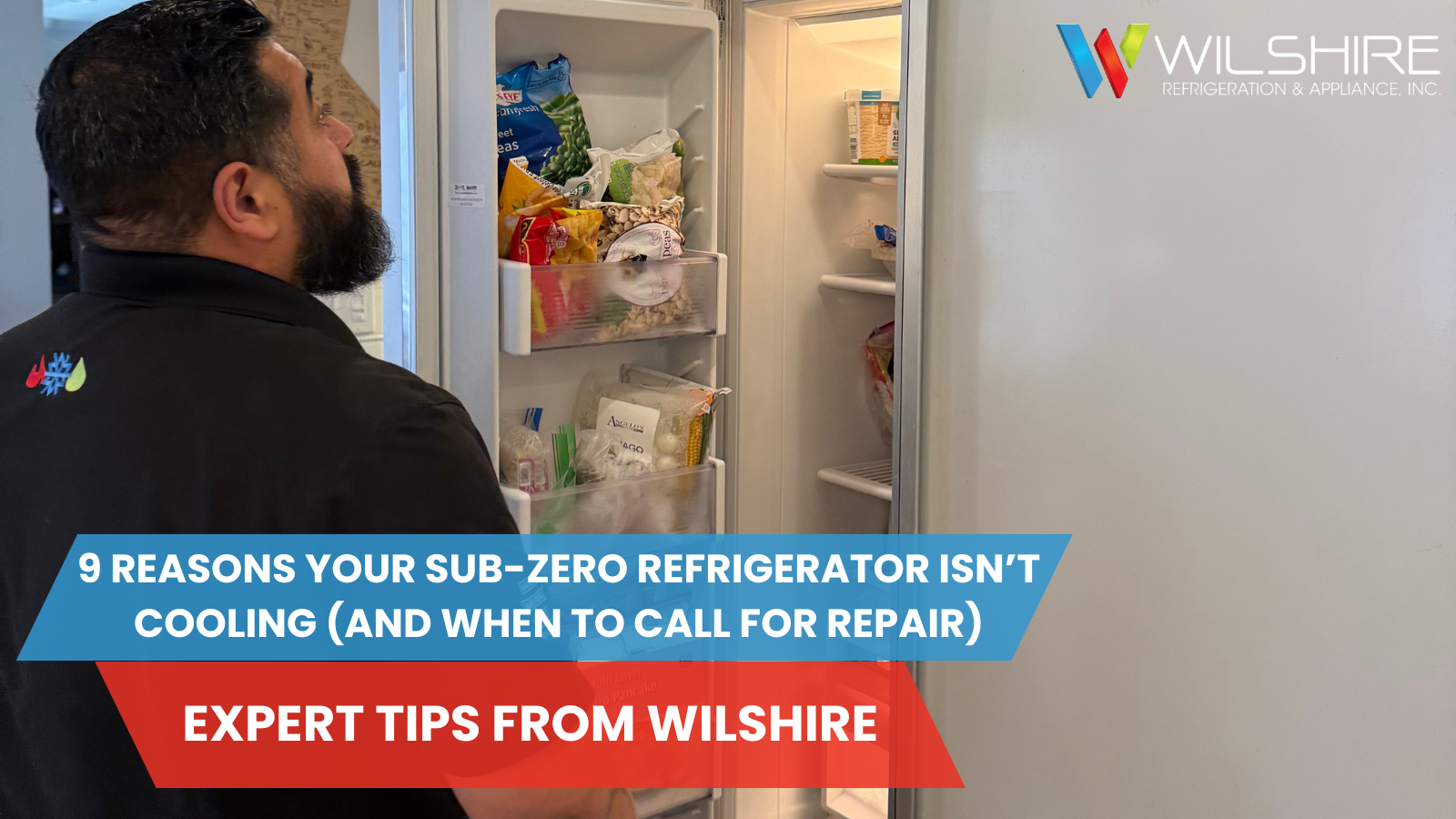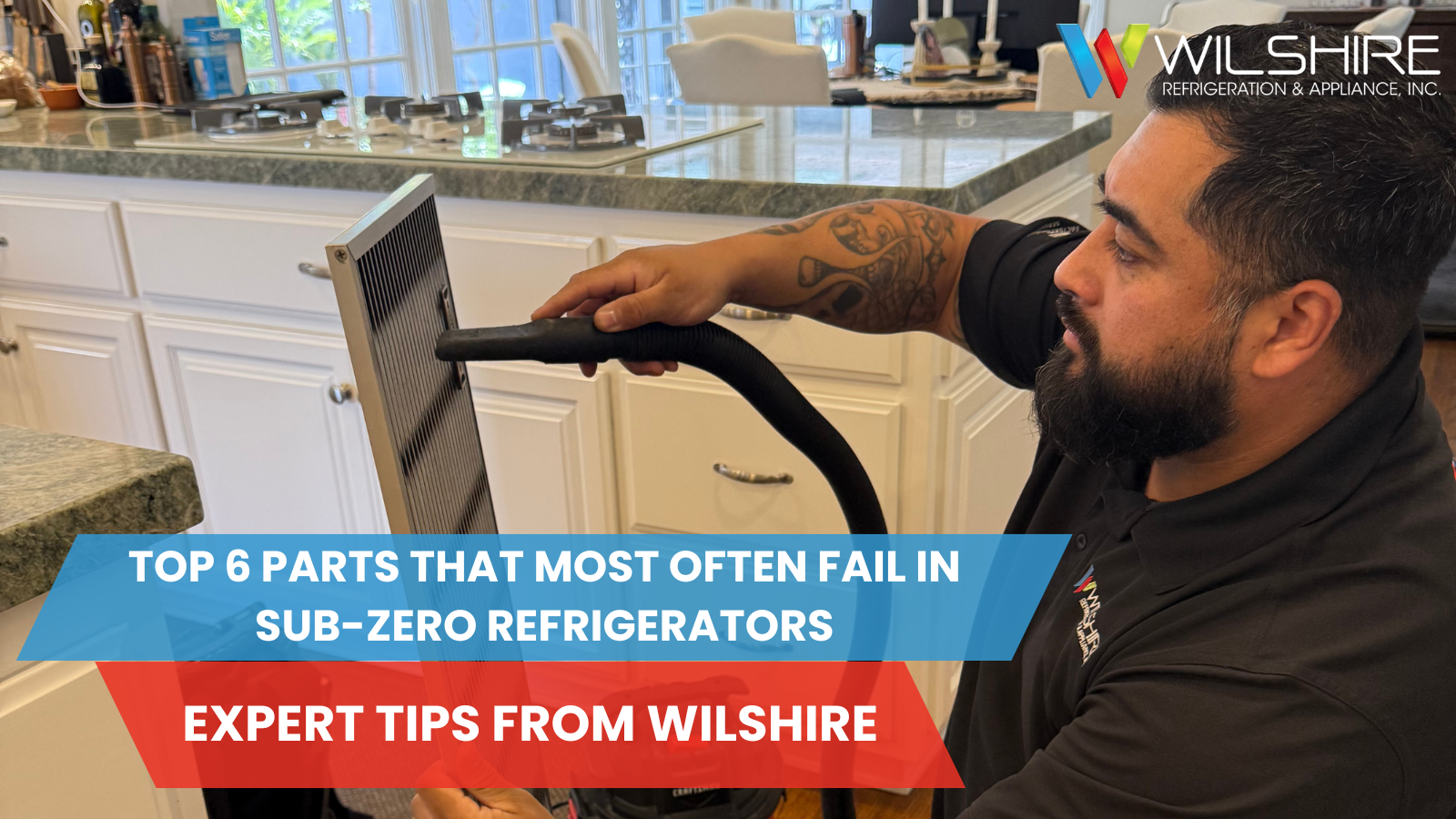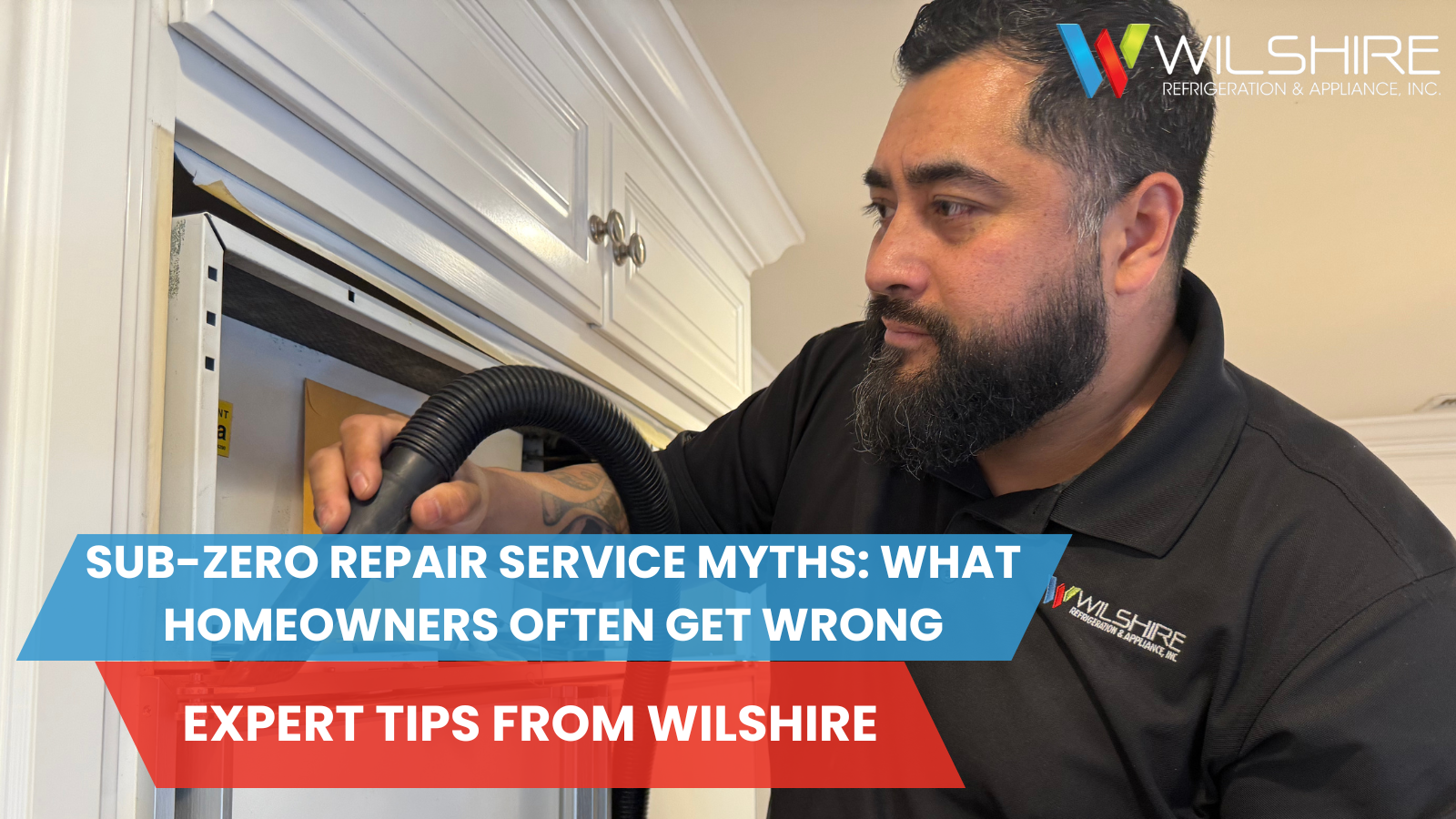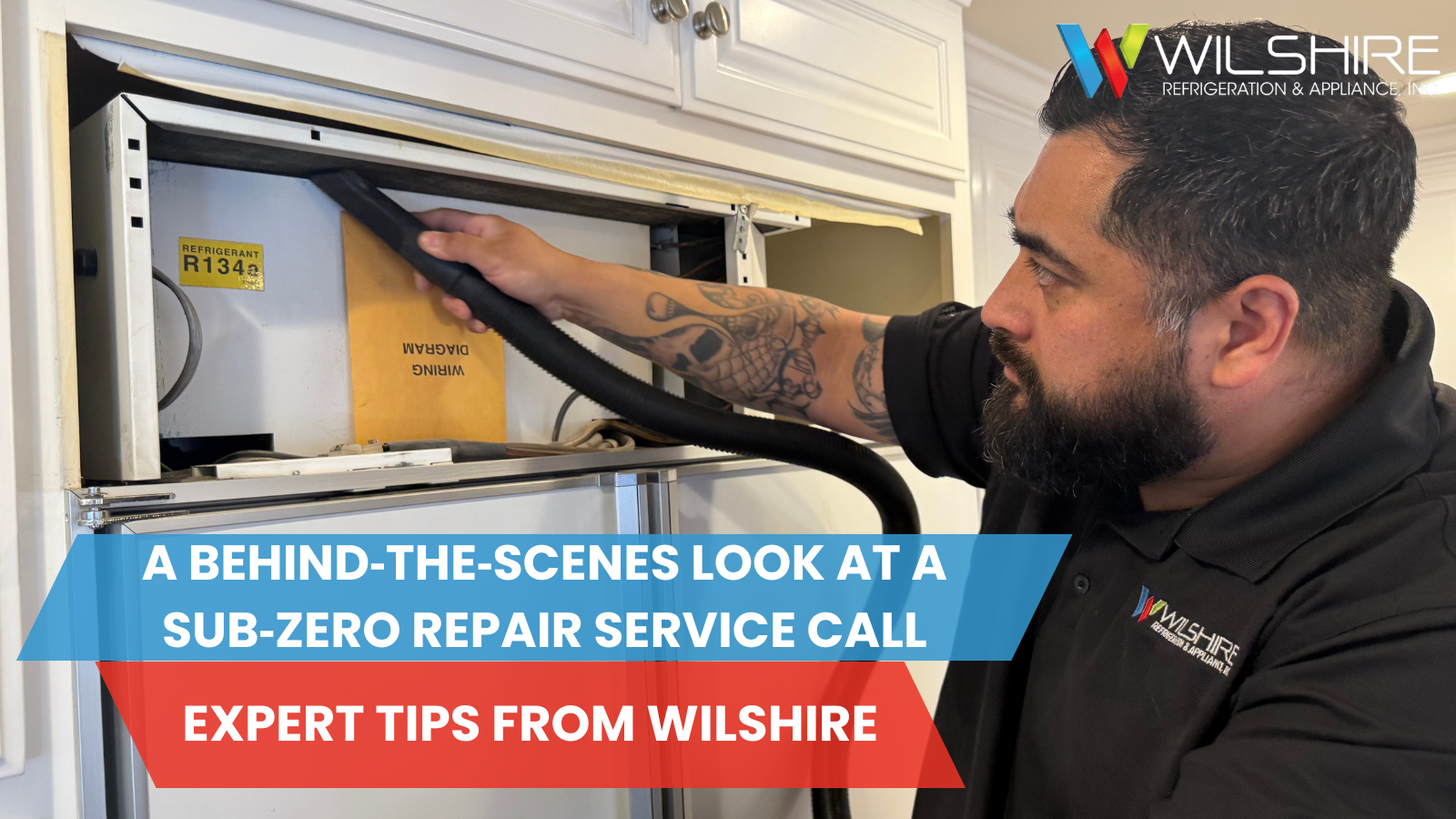The issue with a high-end refrigerator like a Sub-Zero losing its ability to cool goes beyond mere inconvenience. It poses a real risk to thousands of dollars in groceries and signals a serious, possibly escalating, mechanical issue.
When this appliance, known for its longevity, begins to struggle with temperature regulation, produce unexpected noises, or flashes warning indicators, it signals a deeper problem. The following guide details the most frequent causes behind a Sub-Zero’s cooling failure and explains when the time has come to contact a professional, certified repair service.
9 Common Causes Behind Sub-Zero Cooling Failure
When a Sub-Zero unit fails to hold temperature, the root cause is typically mechanical or environmental. Here are the most common culprits.
1. The Condenser Coils Are Heavily Dusted
Dust acts like a thick, insulating blanket on the condenser coils, which are responsible for releasing heat. This buildup traps heat inside the system, forcing the refrigerator to run almost non-stop. This constant strain rapidly diminishes cooling performance and increases energy consumption.
2. The Evaporator Fan Has Stopped Working
This fan is the primary mover of cold air inside the cabinet. If the fan motor fails and the blades stop spinning, the cold air is essentially trapped around the evaporator unit. Without proper circulation, the rest of the refrigerator space warms up slowly but surely.
3. Airflow is Blocked by Contents
Overstuffing the cabinet can be as disruptive as a mechanical failure. The Sub-Zero system relies on specific, unobstructed channels to circulate chilled air. When vents or fans are covered by food containers or bulk items, the temperature distribution is immediately compromised.
4. Temperature Settings Were Accidentally Changed
A surprising number of service calls stem from an accidental change to the control panel settings. During a deep cleaning or a major restocking effort, the temperature dial or digital control can be adjusted without notice. A simple check often resolves a mysterious warming trend.
5. The Door Seal Has Lost Its Integrity
A worn, misaligned, or obstructed door gasket allows warm, humid air to seep into the cabinet while chilled air leaks out. Even a narrow gap over time can drastically alter the internal temperature and force the compressor into continuous operation.
6. The Unit is Not Level on the Floor
When the refrigerator is not sitting evenly, it can create issues that affect the cooling cycle. An off-kilter unit may interfere with the proper function of the compressor, or it may be enough to stop the door from sealing completely. Both outcomes compromise temperature stability.
7. The Unit is Running in Sabbath Mode
Select Sub-Zero models feature a “Sabbath Mode,” which deliberately limits or disables specific functions for religious observance. Crucially, the cooling cycle remains active to preserve food, but the internal lights, door alarms, and ice maker are disabled. If this feature has been activated accidentally, the unit may seem non-responsive, but it will still be cooling.
8. A Core Fan Motor Has Failed
Beyond the evaporator fan, the condenser fan motor is also vital. If either the condenser or the evaporator motor fails, the necessary air movement stops completely. This is a complex mechanical failure requiring a factory-certified technician.
9. The Defrost System Is Faulty
When the defrost heater or sensor stops operating correctly, a thick layer of frost builds up around the evaporator coils. This heavy frost acts as a formidable barrier, blocking airflow and drastically reducing the unit’s ability to maintain a consistent cold temperature.
Initial Troubleshooting Before Scheduling Repair
Before assuming the issue requires extensive Sub-Zero appliance repair, a few basic steps can often resolve minor disruptions:
- Perform a Power Reset: To properly hard-reset a Sub-Zero, the official method is to turn the unit off at the control panel first (or turn the dial to “Off”), then turn off the dedicated home circuit breaker for at least 30 seconds. After restoring power at the breaker, retest the unit. This power cycle ensures the control board fully discharges and resets.
- Clear All Obstructions: Spend a few minutes ensuring no food items are touching the rear wall, blocking vents, or interfering with the door closure.
- Check for Warning Lights: Note any flashing lights, persistent beeping, or digital error codes displayed on the control panel. This information will be crucial for a technician.
If these quick checks do not restore normal cooling performance within a few hours, it may be time to seek a professional diagnosis.
When to Contact a Certified Sub-Zero Repair Technician
Certain problems are too complicated, dangerous, or subtle to attempt solving with do-it-yourself methods. If the unit exhibits any of the following symptoms, an expert is needed immediately.
Flashing Error Codes Are Visible
Sub-Zero systems are engineered to communicate faults via specific error codes. These codes are not often self-explanatory and point directly to internal component issues, requiring the diagnostic tools and specialized training of a certified technician to interpret and resolve.
There is a Burning Smell or Unusual Noise
Any odor suggestive of burning plastic or ozone should be taken as a severe safety concern, likely indicating a wiring or motor burnout. Likewise, unusual grinding, high-pitched whining, or persistent clicking can signal imminent motor or fan failure. Both scenarios require the immediate intervention of a trained repair expert.
Basic Fixes Have Failed and the Unit Remains Warm
If the simple steps, such as cleaning the coils and checking the seals, have been completed but the refrigerator temperature continues to climb, continued use will only lead to more severe, costly damage. At this stage, professional expertise is the only reliable solution.
Internal Moisture or Mold Growth is Apparent
The sudden presence of excessive moisture or a musty odor points to deep-seated issues like a failing defrost system or serious gasket degradation. These moisture-related problems often lead to internal corrosion and are difficult to diagnose accurately without specialized equipment and knowledge.
Food Spoilage is a Recurring Problem
When groceries consistently perish faster than they should, it’s a clear red flag that the unit is experiencing temperature instability. Even slight, undetected temperature swings can create an unsafe environment for food. Do not risk food safety; contact a trusted repair service for a thorough inspection.
Frequently Asked Questions
What generally causes a Sub-Zero refrigerator to stop cooling?
The most frequent causes include heavy dust accumulation on the coils, failure of a core fan motor, accidental tampering with temperature controls, or a broken defrost system.
Why would a Sub-Zero fridge run continuously but fail to get cold?
This is a classic symptom of a condenser or evaporator fan malfunction, blocked air circulation channels, or heavily insulated condenser coils preventing heat release.
Is it safe to reset my Sub-Zero fridge on my own?
Yes. For most models, simply unplugging the appliance for a few minutes and then restoring power will perform a system reset. This is a standard and safe troubleshooting step.
How long can a Sub-Zero refrigerator be expected to last?
With appropriate maintenance and care, these high-end appliances often achieve a lifespan of 18 to 20 years or sometimes even longer.
Is repairing a Sub-Zero refrigerator a worthwhile investment?
Absolutely. Given the premium quality, construction, and high cost of replacement, repairing a Sub-Zero is almost always significantly more cost-effective and sustainable than buying a new unit.
Need Sub-Zero Refrigerator Repair? Call the Experts at Wilshire
If simple troubleshooting has failed to restore your appliance, allow Wilshire to take the next steps. Their certified, factory-trained technicians specialize in Sub-Zero repair, providing service that is fast, professional, and precise. Schedule a certified repair today or call us at (818) 898-9999 for same-day service.




